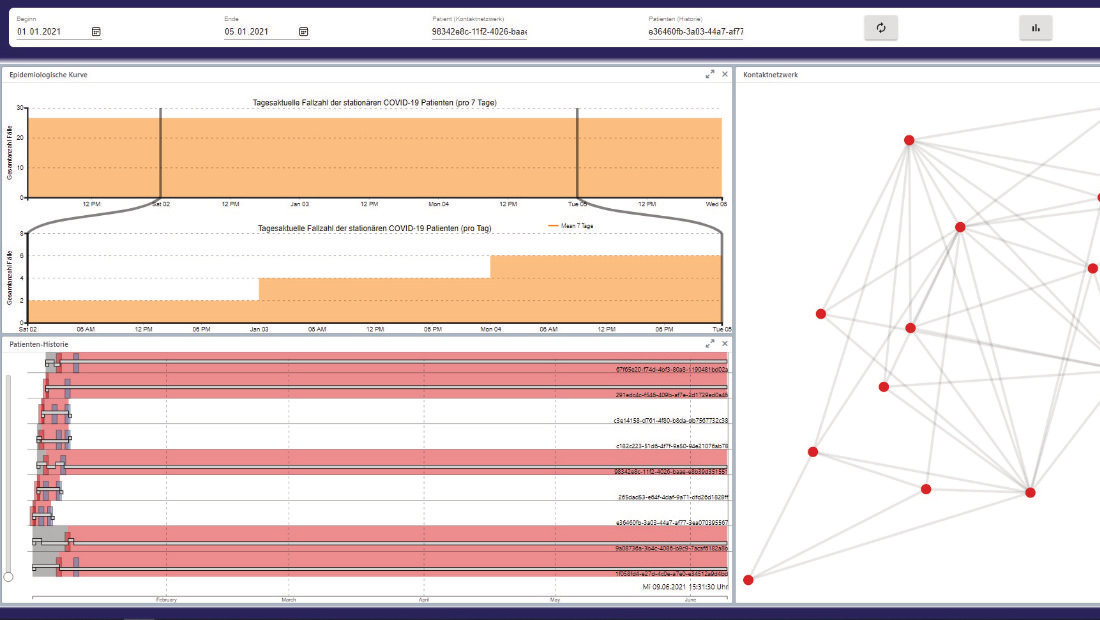Use Case Infection Control (2018-2023)
HiGHmed Consortium
About the project
For centuries, it has been a well-known phenomenon that (disease) pathogens and, if applicable, infectious diseases caused by them occur in human population groups in a temporally and locally clustered manner. Depending on the epidemiological framework, one can speak of an endemic (localized), epidemic (epidemic-like) or - as in the case of COVID-19 - of a pandemic (transnational) occurrence.
Even independently of the COVID-19 pandemic, inpatient healthcare facilities (e.g. hospitals or rehabilitation clinics) are focusing on the hospital hygiene challenge posed by the clustering of pathogens, especially the spread of multidrug-resistant bacterial pathogens (MRB). Pathogen clustering poses enormous challenges to all hospital stakeholders. Serious problems can arise in patient care due to the loss of efficacy of established, well-performing and well-tolerated antibiotic agents in the event of MRB infection. If an infection with such a multidrug-resistant pathogen occurs, this is often associated with a worse clinical outcome and also increased costs for the healthcare system, e.g. due to required alternative therapies or necessary isolation.
"In the HiGHmed Consortium Use Case Infection Control, our team is focusing on using the SmICS software system developed to detect the further spread of multidrug-resistant bacterial pathogens as early as possible. In the best case, diseases and outbreaks can thus be prevented. With this technical support, the high level of expertise of the hygiene staff in the hospitals can be fully utilized to follow up on SmICS alerts and determine whether they are indeed alerts that require intervention."
Prof. Dr. med. Simone Scheithauer
University Medical Center Göttingen
Nosocomial infection
If an infection occurs in a hospital, it is referred to as a nosocomial infection. In Germany, most of these are not caused by MRB. In many cases, MRB are merely colonized with these pathogens on the mucous membranes, e.g. in the intestines and in the nasopharynx. Due to the lack of symptoms, these colonizations are not always recognized promptly (which is initially medically harmless) and such pathogens can thus spread. However, colonization with multi-resistant pathogens can also - just like colonization with non-multi-resistant pathogens - turn into an infection requiring treatment.
Early cluster detection
In the HiGHmed Consortium Use Case Infection Control, a digital system for the early detection of disproportionate clusters of pathogens and possible nosocomial transmission chains is being developed and researched (early cluster detection). The goal is to automatically detect and visualize the further spread of bacterial pathogens using MRB as an example. This early detection of transmission chains can lead to outbreaks being avoided or at least reduced in dimension by implementing appropriate interventions to interrupt them at a very early stage. As a result, patients can be better protected and infections avoided.

Smart Infection Control System (SmICS)
The "Smart Infection Control System" (SmICS) was developed to implement such a digital solution. This enables automated, algorithm-based detection of possible pathogen clusters on the basis of data generated in the care routine. Experts then decide whether an outbreak has occurred. The data required for this is obtained from the medical data integration centers that have been set up at various locations throughout Germany as part of the HiGHmed Consortium.
Movement data
Movement data (i.e., the location of patients in the hospital) and microbiological findings (evidence of bacteria responsible for illnesses) are of particular relevance for the detection of possible pathogen clusters. By means of a standardized query of these databases, which are compiled in the medical data integration centers, it is possible - with the help of statistical analyses and machine learning methods - to trace the temporal and local context in which pathogen detections and contacts between patients occur.

Open standard
The use of an open standard for the representation and storage of medical data (openEHR) enables the integration of source data from diverse, commercial laboratory information systems into a harmonized, standardized data platform accessible via open source interfaces. Due to the standardization of data management and the consistent use of standardized query options and interfaces, the SmICS application can be used at all participating sites without significant modifications.
Thus, developing pathogen clusters can be detected locally and also across sites or facilities. This could lead to a reduction in the number of affected patients in the future. SmICS could also make a decisive contribution to reducing the number of previously undetected and/or unreported cases of pathogen accumulation.
Prof. Dr. med. Simone Scheithauer
University Medical Center Göttingen / Director of the Institute for Hospital Hygiene and Infectiology
Prof. Dr. med. Dr.-Ing. Michael Marschollek, FIAHSI
Peter L. Reichertz Institute for Medical Informatics of the TU Braunschweig and Hannover Medical School / Managing Director, Head of the Hanover site


